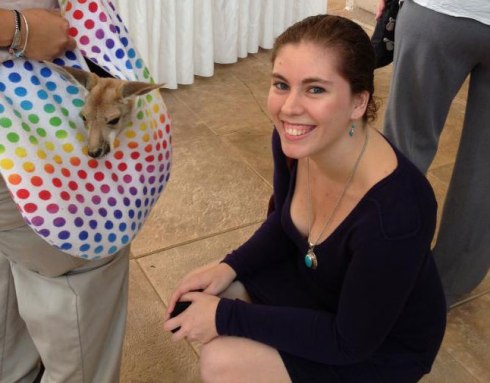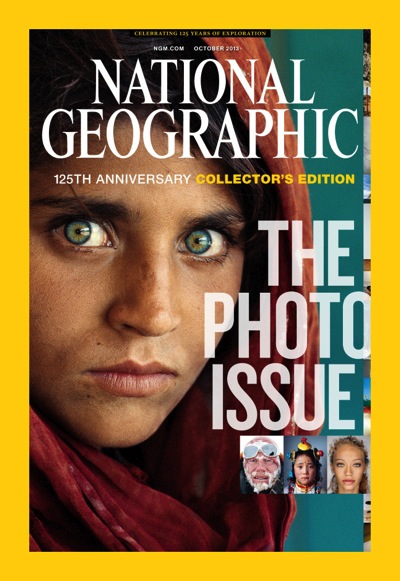Have you ever read a long description that starts out with hair color and length, eye-color, vague height, clothing, and even shoe type? Or worse, characters no longer referred to by name but instead referred to as “the dark-haired man” or the “blue-eyed woman?” Fanfiction especially is riddled with these kinds of descriptors, tacked on like police-reporting details. I’ve read stories that spend paragraphs describing, in great detail, all the many insignificant details of a group of people’s appearances in the hopes of directly transplanting the image of a character from the writer’s mind into the reader’s. It breaks one of the fundamental rules about writing, which is that the reader is reading, not watching a movie.
There are a few things to keep in mind when considering reader psychology and comprehension to understand why this method doesn’t work (unless you’ve got a police officer literally reporting on a suspect’s appearance to the reader). Consider that, while reading The Hunger Games, I thought that Peeta had dark hair until book two, no matter how often he was described as being blond. My examples will feature pictures of me so be prepared!
Think Like a Cartoonist: In Broad Strokes
Let’s use an example to get started so that this is easier to visualize. In terms of improving your writing, visualizing is just another tool to use. Reading books is a great way of seeing how description works or doesn’t work, but won’t necessarily help you to see things in a new and unique way to write for yourself. Go out to a cafe or library, school, work, anywhere that you can watch people go by. Consider how you would describe a person that you see. Cartoonists are the best examples of what you will be doing, that is, thinking of people in broad strokes. When you look at someone, what is the first prominent thing that you notice about them?
Here is an example:

Yup, that’s me. Not the kangaroo of adorable in the rainbow pouch, the one kneeling beside it looking super excited to be there. Aren’t I cute? Anyway, notice that I am very hard to describe in police-reporting style. My hair on my license is described as blond, but it’s tied back right now so how can you tell? It looks kind of brown-reddish. Not a great description, so skip it. I’m white but not pale, so why mention my skin tone unless it’s something really striking? Plus I’m Hispanic so “white” might give someone a weird description of me, missing a fundamental part of my essence. Skip that. I’m wearing a navy dress but it looks black in the picture. Memorable? Not really. I’m wearing some eye-catching turquoise jewelry. Could be useful, jot it down. How about eye color? Can you tell? (It’s blue, but you can’t, so skip that as well).
Since we’ve exhausted all of the really striking descriptions that are typical in books, let’s focus on the one thing that really catches your eye when you look at me in this picture: my smile. Notice that you can see my gums a bit and the smile reaches my eyes (I am super excited about animals, especially cute Joeys in rainbow-colored pouches). So, if you were describing me, you might say something like, “Her smile lit up her entire face, making her seem friendly and approachable.” Do you think there’s a better way to describe what I look like? Think about it.
Now, I’m cheating here a little. When I ask people what is the first thing they think of when they think of me, the very first thing people tell me is: my crazy hair. The picture I showed above has my hair tied back so be aware when you are writing description that everything should be handled within a particular context. If your character’s defining trait is something like hair and he or she is in a situation where you can’t see it, how would he or she be described? To give you an idea, check out my hair below.

I know, right? Pretty striking hair, and that’s with product in it to keep it tame. To give you an idea of how memorable my hair is, a good friend of mine has something called “Prosopagnosia,” or face blindness. She can’t recognize people from their faces at all. She even has trouble recognizing facial expressions as expressing their thoughts, emotions, or intentions. Normally, she compensates with things like voice and body language, meaning that she tends to wait until someone speaks to recognize who they are, even her own mother. How did she pick me out of a crowd? My crazy hair, every time.
So, if I’m a character from a book, the two main things that seem to really grab people’s attention about me are: my hair and my unusual smile. My brother is famous for his big blue eyes, my father is famous for his tall, serious countenance and big Italian nose, and my mom is famous for her cat-like green eyes and athletic build. My father and I don’t have such striking eye-color, as you can see, but my mother and brother do. Apply what works.
These descriptions work just fine for describing me but how can I apply this to my actual writing, you might be asking? Excellent question.
Startling and Unusual Get All the Attention
Ever met a biracial person with really striking coloring? Remember this cover?

See how her striking green eyes are in the face of a slightly darker skin-tone? Also notice that her gaze is intense and focused, something that tends to grab a person’s attention. Or how about this famous actor?

(As a side note, using celebrity images as references for characters is a great exercise, as long as you limit your description to the key things you notice about them. Don’t be surprised if your readers add more description than you provided for them, as long as you give the “feeling” of the person. More on that as we continue).
Notice that this actor has darker skin and very light eyes, very striking because of their unusual pairing. This is the same sort of effect as having very dark hair and very pale skin, or bright freckles, or anything memorable or unusual. This is also why scars are so popular to highlight in books and anime. When it comes to describing characters in your own writing, you need to pick one or two key details that strike you first about a person, as that is how we as humans categorize and remember people. This is also why sometimes, if a person makes a drastic change like cutting and dying his hair, we don’t always recognize him immediately.
The only people who have noticed and commented on the two moles I have on my face (can you spot them in my pictures?) are usually the people who spend the most time staring at my face from a close proximity. That is, people I am dating and my family. Most other people do not notice those little details.
One cautionary note: because of the prominence of movies and tv shows, we have been conditioned to only pay attention to people’s faces and expressions (this is why we often write descriptions of hair and eye color). There is more to people than just their face. Height is an easy one, but body shape often plays a role. People come in all shapes and sizes: sometimes the way someone is put together is just as striking as any one or other feature. This is where you get descriptions of “bean-pole” and “pear-shaped.” Consider this when writing.
Which leads us to the next point….
Descriptions are Dependent on Point of View
Remember how I said that police-reporting (blond hair, blue eyes, five-foot four, lithe, freckles, 140lbs) is acceptable if you have a cop as your point of view narrator? This same concept carries into all of your characters. It brings up the first of many axioms I hope to introduce over time, the first one being:
Does it make logical sense?
Who is your main character? What kind of person is he or she? What is this person likely to notice? When coming up with this information, it’s best to use the Socratic method, that is constantly asking yourself questions. Your main character is blond: why? Does it matter? Should that be the defining characteristic or is there something more noteworthy?
A thief may notice things like, “Aristocratic nose, soft hands, easy target” or “Calloused handshake, shifty eyes, second-hand clothing” because these are observations that would help with her trade. Who is an easy target? Where would her eyes, therefore her attention, go in observing people? If she is constantly looking for purses, wallets, and jewelry, her eyes will be focused on hands (rings and watches), hips (pockets and purses), and eyes (have they noticed my hand in their coat? Are they going to report me? Where is their attention? Can I slip by unnoticed?).
A soldier, on the other hand, might be more focused on other things: look at the chest or shoulder for rank on a uniform (how should I behave in front of a superior office vs. someone below my rank), what kind of uniform (friend or foe), quick descriptions of people to recognize them in a battlefield (that red hair won’t be useful if it’s under a helmet), strength of a handshake and focus in a glance (is he or she going to have my back if we get into a fight?), tone of voice (will he or she be commanding the group well?).
What about a teenager? A rebellious teenager who hates conformity and loves creative expression might express herself by an observation like, “The popular girls, all the same Barbie-like blond hair and skinny jeans,” and “The punk rock chick in class with the green dreadlocks and nose ring.” Both of these descriptions are doing double-duty: they tell you who she is looking at, and how she is looking at them.
Here is your second writing axiom:
Put in the extra work.
Do double-duty, with your descriptions and your characters. When considering description, go beyond just reporting what he or she looks like: whatever you describe should tell you a little something extra about that person or group of people.
What does my crazy hair and unique smile tell you about me? Remember my description? “Friendly and approachable” is linked to my smile. I have been told that I am easy to talk to and approachable, putting people at ease enough that they tend to spill their deepest, darkest secrets to me. My wild hair makes me seem like someone unusual, someone who maybe wouldn’t judge another person because of his or her opinion or experience. My smile also implies I laugh a lot, maybe don’t take things too seriously. That might mean I’m fun to talk to, easy to get along with.
Does this description make it feel like I am somehow more real? We don’t need to get into my hair color, my eye color, my skin tone, or anything else. My hair and my smile tell you a lot about what kind of person I am, what it’s like to be around me, and what I’m likely to talk about or the people likely to approach me. It will also tell you a lot if you ask a family member to describe me–my great-grandmother loved to comment on the moles on my face because she had the exact same moles in the exact same spots on her own face–or if my classmate describes me–just the other night, a friend commented that it was always my hair that popped into her head when she thought of me.
So, for your first practice at getting better at descriptions, try it out. Avoid describing hair and eye color unless it is the first thing that hits you about someone, and height only if someone is very tall, very short, or the same height as your narrator. Remember context, too. Height doesn’t really matter unless you are, say, arguing with someone and really want that extra inch on them to be more intimidating. Take your main character to start with: how would someone else describe him or her? What does that description say about their relationship to each other?
